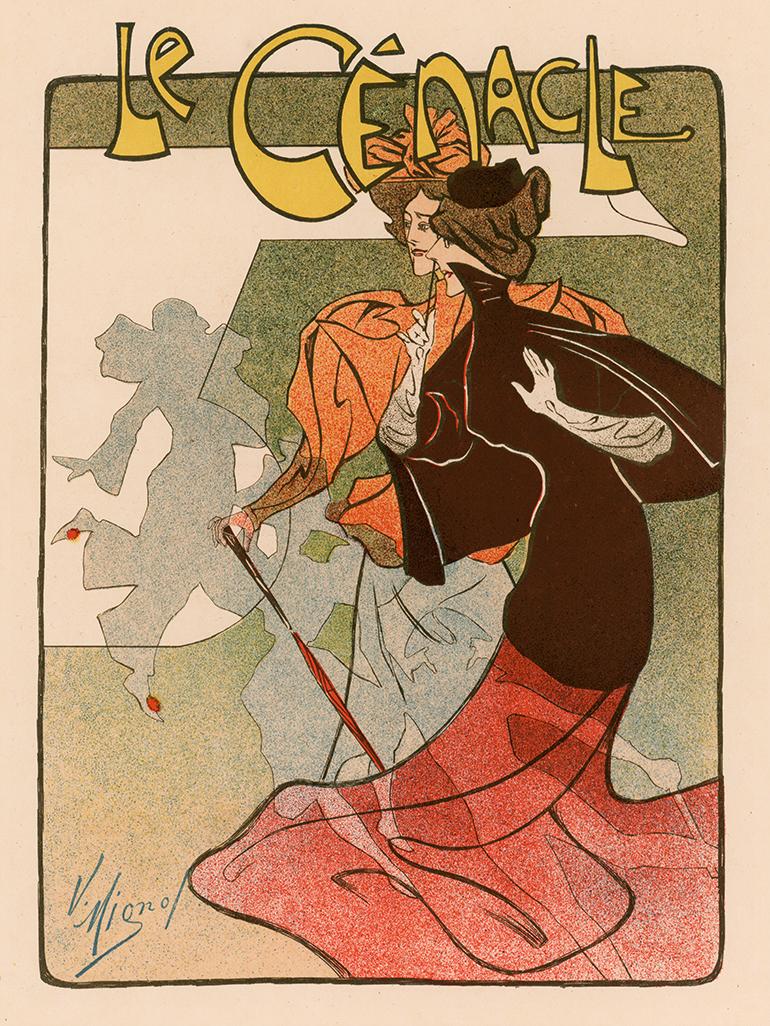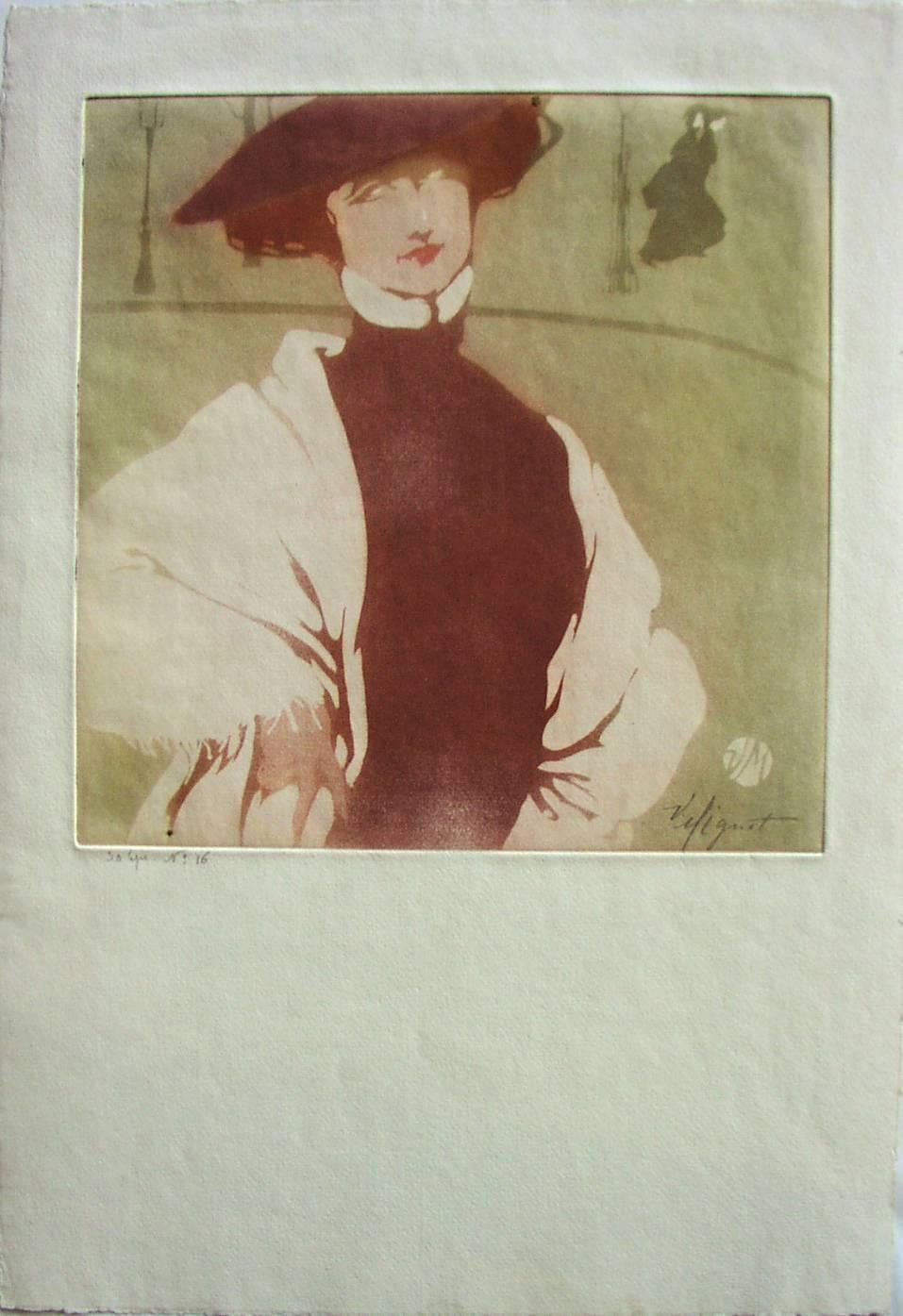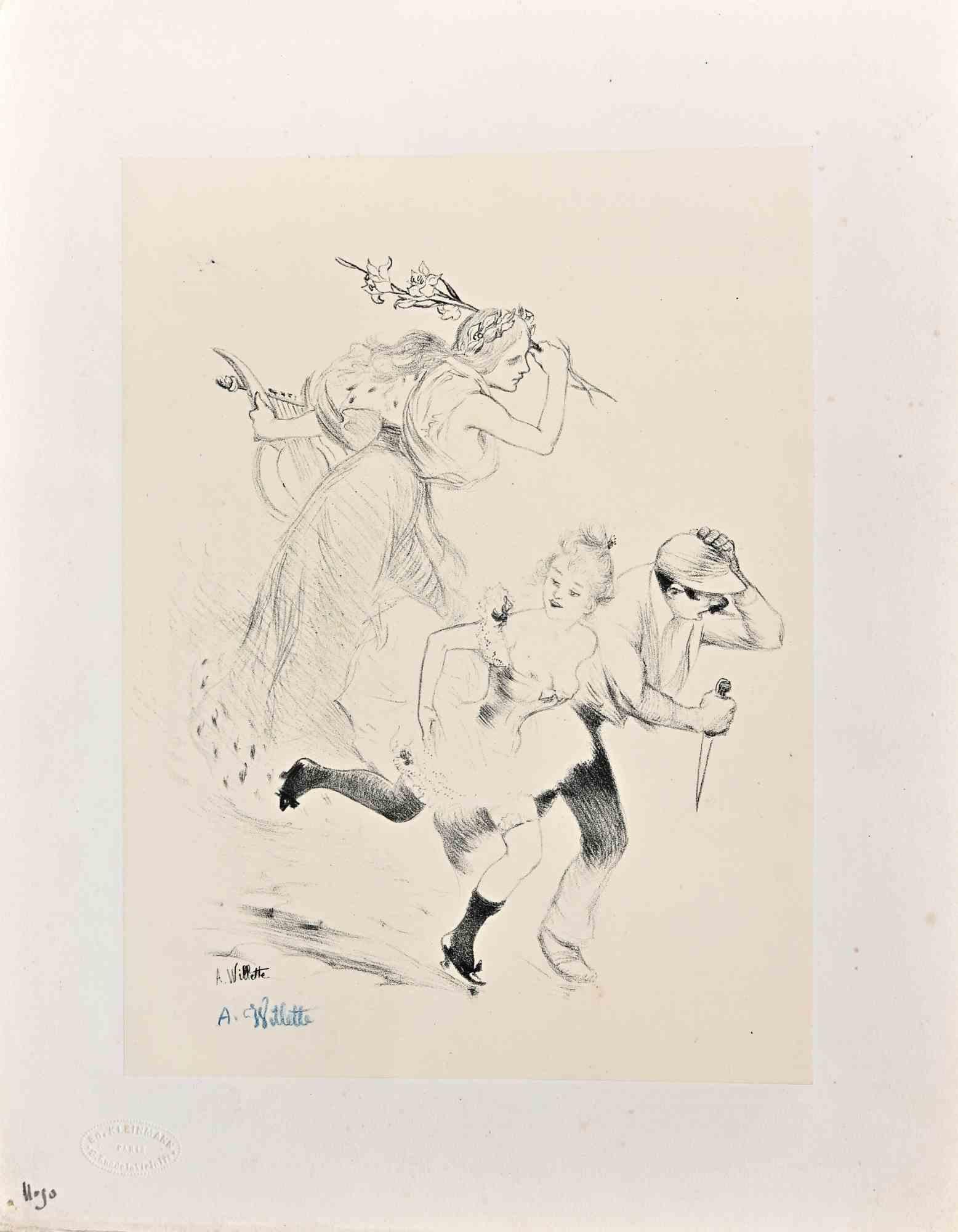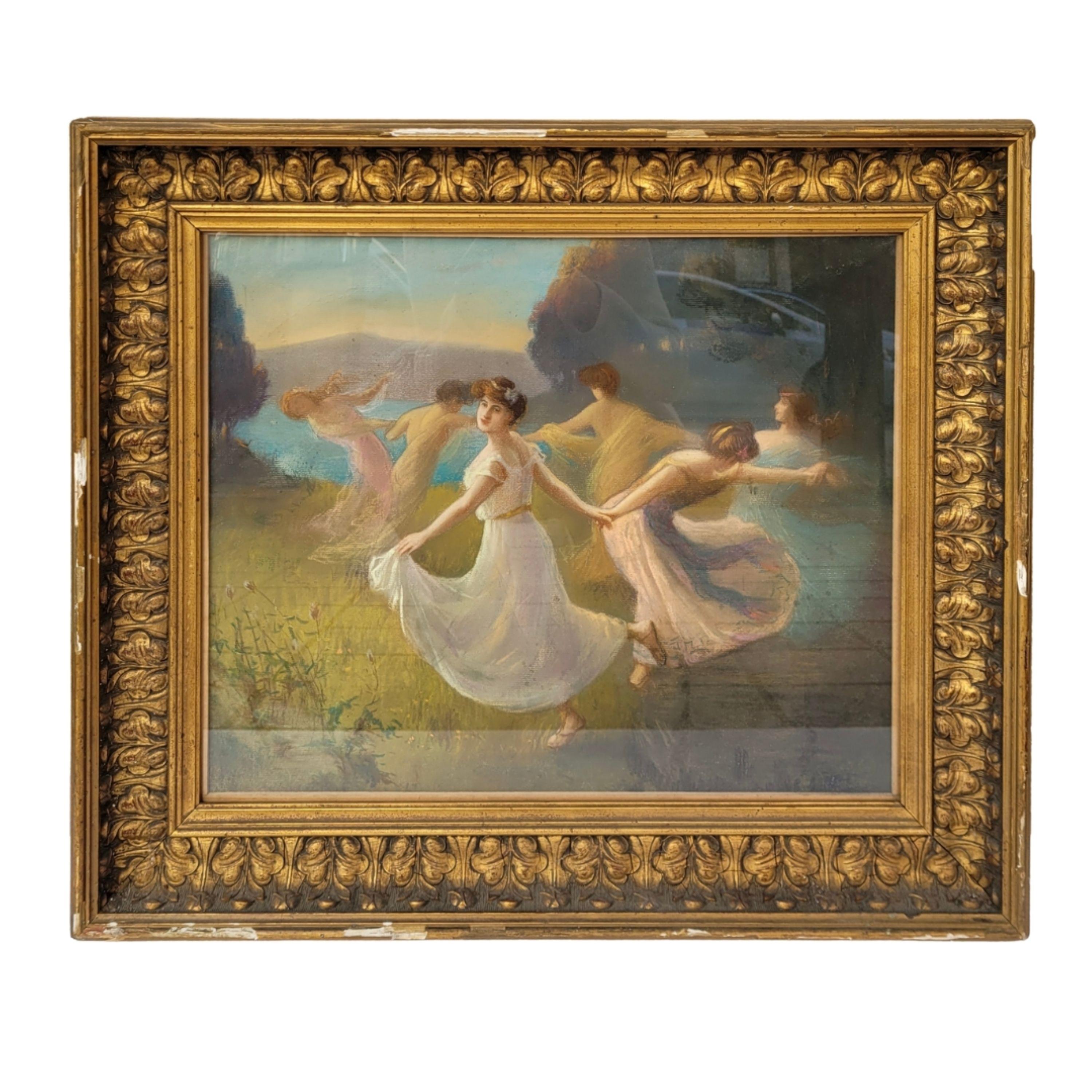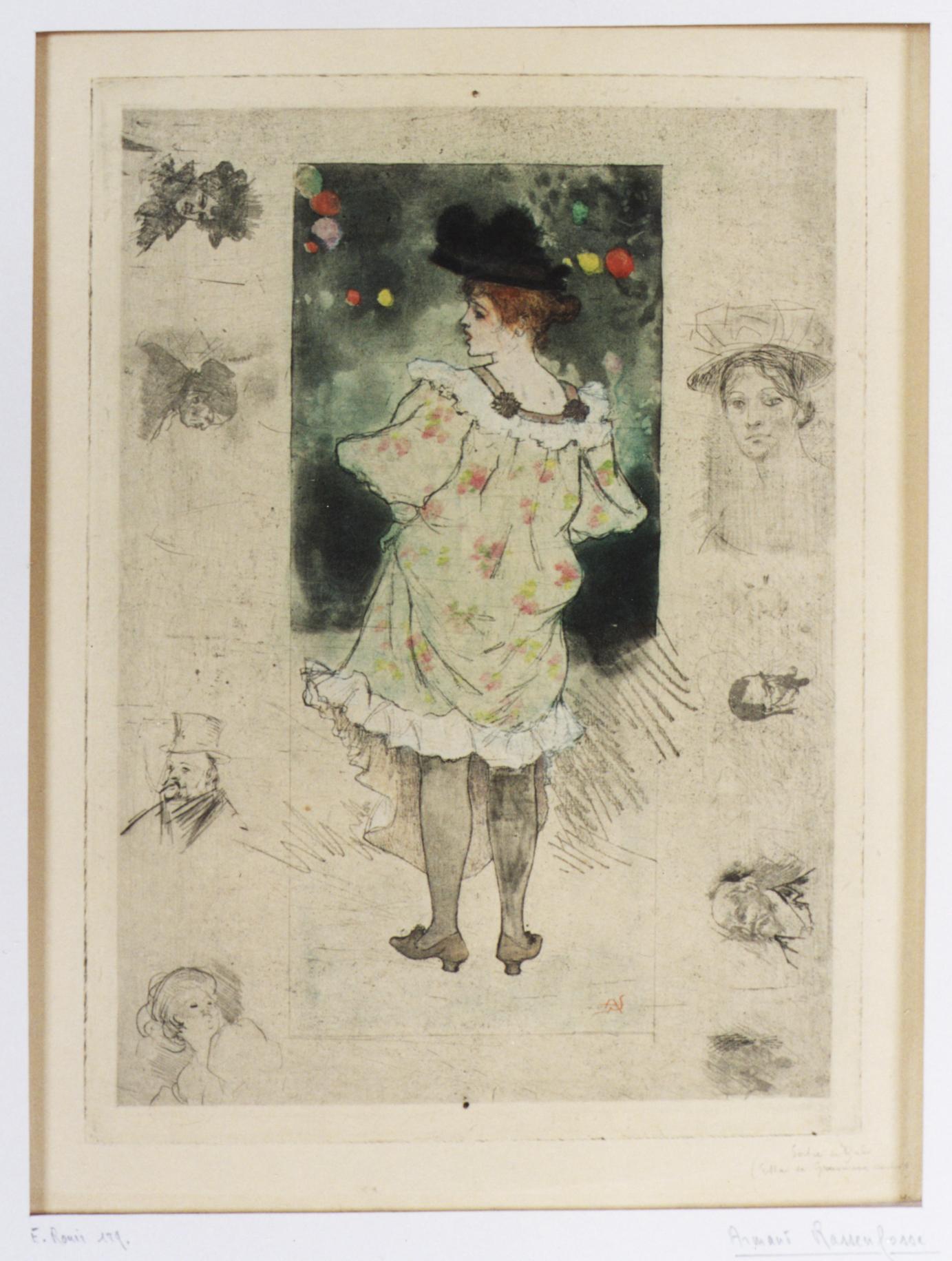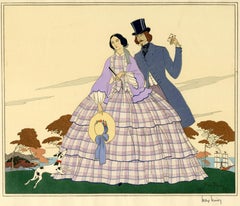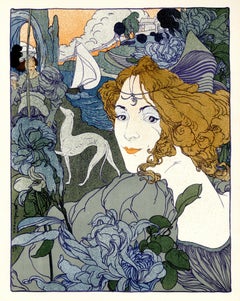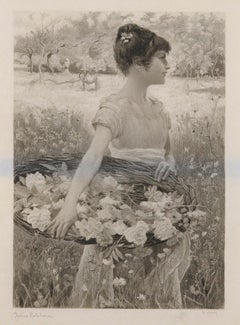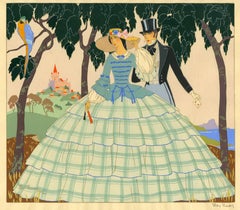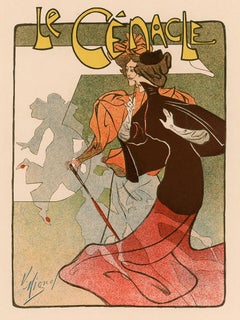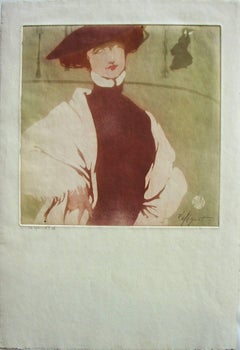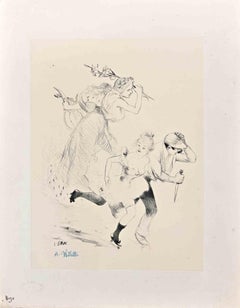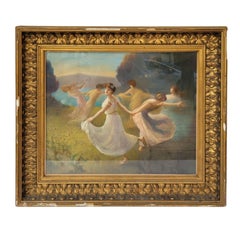Items Similar to Heureux age! (Happy Age!)
Want more images or videos?
Request additional images or videos from the seller
1 of 11
Victor MignotHeureux age! (Happy Age!)c. 1900
c. 1900
$600
£465.35
€527.46
CA$858.70
A$938.31
CHF 486.45
MX$11,209.45
NOK 6,190.39
SEK 5,795.67
DKK 3,938.65
About the Item
Heureux age! (Happy Age!)
Etching and aquatint. c, 1900
Signed lower right in pencil
Edition; 50 (14/50)
Published by Edmund Sagot, Paris
Sagot blindstamp, Lugt 2254, lower right
Condition: a few spots of stray printer's ink just above the plate upper mark, otherwise mint, nver matted or framed
Image size; 10 1/8 x 19 1/8 inches
Sheet size: 17 1/4 x 24 1/16 inches
Provenance: Heirs of the publisher, by decent
VICTOR MIGNOT (1872 - 1944)
"Painter, printmaker and lithographer Victor Mignot was born in Brussels in 1872 and began his career as a book illustrator in an era when the illustrated book had receded in popularity. Full of confidence and a sense of youthful immortality, the nineteen-year-old Mignot then persuaded the publisher of a new magazine, Le Cycliste Belge, to hire him as its designer/illustrator. Though Cycliste Belge did not last for very long, his experience inspired Mignot to design and publish an illustrated sporting paper, where his skills as an artist flowered. From this point forward, his designs enjoyed great popularity, and while his output included all manner of commissioned work including menus and etchings, it is for his posters that he is best known. A skillful draftsman and printmaker, Mignot produced a number of beautifully rendered etchings throughout his long career. He died in Brussels as the Second World War drew to a close."
Courtesy Brier Hill Gallery
- Creator:
- Creation Year:c. 1900
- Dimensions:Height: 10.125 in (25.72 cm)Width: 19.125 in (48.58 cm)
- Medium:
- Movement & Style:
- Period:
- Condition:
- Gallery Location:Fairlawn, OH
- Reference Number:Seller: FA118861stDibs: LU14014530862
About the Seller
5.0
Recognized Seller
These prestigious sellers are industry leaders and represent the highest echelon for item quality and design.
Gold Seller
Premium sellers maintaining a 4.3+ rating and 24-hour response times
Established in 1978
1stDibs seller since 2013
824 sales on 1stDibs
Typical response time: <1 hour
Associations
International Fine Print Dealers Association
- ShippingRetrieving quote...Shipping from: Fairlawn, OH
- Return Policy
More From This Seller
View AllCoquette
By Victor Max Ninon
Located in Fairlawn, OH
Coquette
Pochoir (silk screen) printed in colors, c. 1923-1925
Signed by the artist in pencil lower right; numbered in ink on the image, (see photo)
Edition: 250 (100/250) in pencil in image (see photo)
Image size: 10-1/2 x 12-3/4"
The artist won a gold medal in Paris in 1925 for his porchoirs
Victor Max Ninon (Vittorio Accornero de Testa, Italian, 1896-1982)
Biography
Vittorio Accornero de Testa was born in Casale Monferrato in 1896. He completed his first studies at the "Leardi" institute, but was forced to interrupt them due to the war events of the First World War . At 19 he was second lieutenant of the Alpine troops and in 1916 he took one of the first pilot's licenses. During the war he knows the bitterness of shooting down in air combat (for which he is decorated), but also the good fortune to stay alive, albeit with a disability. His art blossomed in the postwar period, first signing his works simply Ninon and then, probably at the suggestion of a French publisher, under the pseudonym of "Victor Max Ninon" (Victor and Max indicate strength and masculinity, Ninon boyhood) .In 1919 and 1924 he made illustrations for theGiornalino della Domenica , also together with his first wife Edina Altara , for Ardita and La Lettura . In 1923 he won the cover competition organized by the magazine El Hogar of Buenos Aires and in 1925 with his pochoirs he imposed himself in Paris at the international exhibition of modern decorative and industrial arts , obtaining a gold medal. In the same year he made two covers for the US magazine The Smart Set . In the 1920s he made numerous series of art deco style postcards for the Milanese publishing house Degami . On June 4, 1929, aGenoa embarks on the Conte Grande together with his wife Edina Altara , for New York . The two stayed in the American metropolis for a few months: in this period Accornero worked on the creation of theatrical sets and created some covers for Country Life magazine . Accornero gets awards and prizes, but the great economic crisis of the time and the nostalgia for Italy convince the two to return to their homeland, where they resume their activity as illustrators.
In 1934 Accornero moved to Milan, separated amicably from his wife and continued to dedicate himself to the illustration of children's books, abandoning the pseudonym Victor Max Ninon. It illustrates about 60 books, from the fables of Andersen , Perrault and Grimm , to the tales of Poe , as well as the famous Pinocchio and Cuore published by Mondadori, Mursia, Hoepli, Martello. Several books illustrated by Accornero have been published in French, Spanish, German and English. In addition to the periodicals already mentioned, he collaborates on the first edition of the Encyclopedia of Boys , Mondadori, and with the Italian magazines Lidel , Il Secolo XX, The Italian Illustration , Fantasies of Italy , The Woman , Cordelia , For You Lady , Grace , Metropolis , La Domenica del Corriere , The Corriere dei Piccoli .
In 1936 enters the world of cinema, creating sets and costumes for Wedding Vagabonde of Guido Brignone and The White Squadron of Augustus Genina . From 1935 to 1950 he also devoted himself to the theater, taking care of sets and costumes for numerous operettas, ballets and performances at the Scala in Milan and for the Milanese theaters Manzoni, Lirico and Olympia. Stages Marcello di Giordano, Nina pazza d'amore by Paisiello, I cantori di Nurimberga by Wagner, La Bohème by Puccini and other works. For this activity he is also cited in the Theater encyclopedia.
In the 1940s and 1950s he wrote and illustrated six books for children for Mondadori: Tomaso (1944), Giacomino (1949), Tomaso Cacciatore (1950), Zio Stefano (1950), In Campagna che delizia! (1953), Tomaso, dear Tomaso (1955). His illustrations of Perrault's Tales published in those years by Hoepli are famous.
His art in the fifties evolves towards hyperrealism . There are many personal exhibitions in Italy and abroad, including those at the Gallerie Gussoni (1959) and Bolzani (1963 and 1966) in Milan and Walcheturm (1962) in Zurich. Eminent critics praise his work, from Orio Vergani to Enrico Piceni, from Reto Roedel to De Chirico himself. On the Domenica del Corriere , the journalist, writer and painter Dino Buzzati...
Category
1920s Art Deco Figurative Prints
Materials
Stencil
Retour (Homecoming)
By Georges De Feure
Located in Fairlawn, OH
Retour
Color lithograph, 1897
Signed in the stone lower left edge of the image (see photo)
As published in "L'Estampe Moderne"
L'Estampe Moderne appeared each month as a portfolio of...
Category
1890s Art Nouveau Figurative Prints
Materials
Lithograph
Connais-tu le Pays (Primavera) apres J. Rolshoven (Do you Know the Country)
By Theophile Narcisse Chauvel
Located in Fairlawn, OH
Connais-tu le Pays (Primavera) apres J. Rolshoven
(Do you Know the Country -Spring)
Etching, 1889
Signed "Julius Rolshoven" in pencil...
Category
1880s Barbizon School Figurative Prints
Materials
Etching
En Espagne
By Victor Max Ninon
Located in Fairlawn, OH
En Espagne
Pochoir (silk screen) printed in colors
Signed by the artist in pencil lower right
The artist won a gold medal in Paris in 1925 for his pochoirs
Condition: Excellent
Image...
Category
1920s Art Deco Figurative Prints
Materials
Screen
L'Aieule (The Grandmother)
By Louis Legrand
Located in Fairlawn, OH
L'Aieule (The Grandmother)
Etching and aquatint printed in colors, 1904
Signed with the red stamp of the publisher, Gustave Pellet, Lugt 1193 and numbered (see photo)
Edition: 100 (81/100)
Reference: Arwas 202 iv/IV
IFF 98
Condition: Excellent, the sheet aged as usual
Image size: 14 1/4 x 18 5/8"
Sheet size: 16 15/16 x 24 1/4"
Louis Auguste Mathieu Legrand (29 September 1863 – 1951) was a French artist, known especially for his aquatint engravings, which were sometimes erotic. He was awarded the Légion d'honneur for his work in 1906.
Life
Legrand was born in the city of Dijon in the east of France. He worked as a bank clerk before deciding to study art part-time at Dijon's Ecole des Beaux-Arts. He won the Devosge prize at the school in 1883.[2] In 1884 Legrand studied engraving under the Belgian printmaker Félicien Rops.
Legrand's artworks include etchings, graphic art and paintings. His paintings featured Parisian social life. Many were of prostitutes, dancers and bar scenes, which featured a sense of eroticism. According to the Hope Gallery, "Louis Legrand is simply one of France's finest early twentieth century masters of etching." His black and white etchings especially provide a sense of decadence; they have been compared to those of Henri de Toulouse-Lautrec, though his drawings of the Moulin Rouge, the can-can dance and the young women of Montmartre preceded Toulouse-Lautrec's paintings of similar scenes. He made over three hundred prints of the night life of Paris. They demonstrate "his remarkable powers of observation and are executed with great skill, delicacy, and an ironic sense of humor that pervades them all."
Two of his satirical artworks caused him to be tried for obscenity. The first, "Prostitution" was a symbolic drawing which depicted a naked girl being grasped by a dark monster which had the face of an old woman and claws on its hands; the second, "Naturalism", showed the French novelist Émile Zola minutely studying the thighs of a woman with a magnifying glass. Defended by his friend the lawyer Eugène Rodrigues-Henriques (1853–1928), he was found not guilty in the lower court, but was convicted in the appeal court and then given a short prison sentence for refusing to pay his fine.
Legrand was made famous by his colour illustrations for Gil Blas magazine's coverage of the can-can, with text by Rodrigues (who wrote under the pseudonym Erastene Ramiro). It was a tremendous success, with the exceptional quantity of 60,000 copies of the magazine being printed and instantly sold out in 1891.
In 1892, at the instigation of the publishing house Dentu, Legrand made a set of etchings of his Gil Blas illustrations. The etchings were published in a book, Le Cours de Danse Fin de Siecle (The End of the Century Dance Classes).
Legrand took a holiday in Brittany, which inspired him to engrave a set of fourteen lithographs of simple country life called Au Cap de la Chevre (On Goat Promontory). It was published by Gustave Pellet who became a close friend of Legrand's. Pellet eventually published a total of 300 etchings by Legrand, who was his first artist; he also published Toulouse-Lautrec and Félicien Rops among others.
He did not only work in graphics; he exhibited paintings at the Paris salon of the Société Nationale des Beaux-Arts starting in 1902. In 1906 he was made a chevalier of the Légion d'honneur.
Legrand died in obscurity in 1951. A retrospective exhibition was held at the Félicien Rops museum in Namur, Belgium in 2006 to celebrate his graphic art. The art collector Victor Arwas published a catalogue raisonné for the occasion.
Books illustrated
de Maupassant, Guy: Cinq Contes Parisiens, 1905.
Poe, Edgar Alan: Quinze Histoires d'Edgar Poe...
Category
Early 1900s Art Nouveau Figurative Prints
Materials
Aquatint
Moto-Fuite
By Georges Meunier
Located in Fairlawn, OH
Moto-Fuite
Color lithograph, c. 1902
Signed in the stone lower right (see photo)
Published by Edmund Sagot (1857-1917), Paris
Printed by Atelier Chaix, Paris
Large edition with titl...
Category
Early 1900s Art Nouveau Figurative Prints
Materials
Lithograph
You May Also Like
Le Cénacle by Victor Mignot, Art Nouveau Commedia dell'Arte lithograph, 1897
By Victor Mignot
Located in Chicago, IL
Elegantly-dressed society women observe silhouettes of Commedia dell’Arte characters Pierrot, Columbine, and Harlequin at the shadow play theater Le Cénacle.
In a manner reminiscent...
Category
1890s Art Nouveau Prints and Multiples
Materials
Lithograph
Color Aquatint
By Victor Mignot
Located in New York, NY
Ca. 1900. Original color aquatint. Very fine impression on cream laid Arches paper, signed in pencil lower right and numbered. No. 16 of 30 impressions. Full Margins. 17 1/2 x 12" Im...
Category
Early 1900s Art Nouveau Figurative Prints
Materials
Aquatint
Dangerous Jokes - Lithograph by Adolphe Willette - Early 20th Century
By Adolphe Willette
Located in Roma, IT
Dangerous Jokes is an Original Lithograph realized by Willette (Adolphe Léon).
Good condition on a yellowed paper.
Hand signed with blue pencil on the lower left corner.
Adolphe ...
Category
Early 20th Century Art Nouveau Figurative Prints
Materials
Lithograph
Art Nouveau Pastel on paper Dance Leopold François Kowalski
Located in Valladolid, ES
Gorgeous Pastel on paper “Dance”, studio of Leopold François Kowalski, early 20th century.
This exceptional pastel depicts a group of women dancing in a romantic, ethereal spring la...
Category
Early 1900s Art Nouveau Figurative Drawings and Watercolors
Materials
Paper
Sortie De Bal - After The Ball
By Armand Rassenfosse
Located in New York, NY
Rassenfosse, Armand.( 1862-1934) Sortie De Bal, 1894. Original drypoint in colors on Japan, initialled in red ink by artist with his monogram. Beautiful impression. In addition, the ...
Category
1890s Art Nouveau Figurative Prints
Materials
Drypoint
'Three Young Beauties', Art Nouveau, Boston Museum of Fine Arts, Musée Bordeaux
Located in Santa Cruz, CA
Signed lower right, “Ch. Henrida” for Charles Henrida (French, 1854-1924) and painted circa 1900.
Unframed and displayed in a beveled, ivory mat with gilt inner slip.
Matted dimens...
Category
Early 1900s Figurative Drawings and Watercolors
Materials
Paper, Watercolor, Gouache
More Ways To Browse
Antique Menu
Anders Zorn Etchings
Andy Warhol Dollar Sign
Andy Warhol Electric Chair Art
Antique Lawyer Prints
Arnold Friberg
Atoms For Peace
Bill Katz
Book Of Job William Blake
Book Of Mormon
Botero Fernando Lithograph
Botero Lithograph
Carlo Gregori
Christian Dior Vintage Posters
Dali Bullfight
Dali Chevalier
Dali Frank Hunter
Dali Peter
